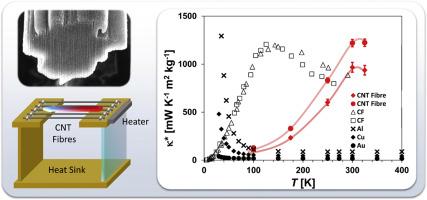
Submitted by Administrator on Mon, 12/12/2016 - 10:46
A new paper by Thurid S. Gspann, Stefan M. Juckes, John F. Niven, Michel B. Johnson, James A. Elliott, Mary Anne White, Alan H. Windle is published in Carbon.
Abstract
Thermal conductivity of carbon nanotube (CNT) films and micro-fibres synthesised by floating catalyst chemical vapour deposition was measured by the parallel thermal conductance method. CNT films showed in-plane thermal conductivities of 110 W m−1 K−1. Online condensation into a micro-fibre morphology – a two-dimensional reduction in the transverse plane, including some axial stretching during solvent evaporation – resulted in room-temperature thermal conductivity values as high as 770 ± 10 W m−1 K−1, which is the highest thermal conductivity reported for CNT bulk materials to date. In specific terms, this matches the maximum thermal conductivity of heat-treated carbon fibre, but with a higher onset temperature for Umklapp scattering processes (300 K rather than 150 K). We selected four sample types to investigate effects of alignment, purity, and single- or multi-wall character on their thermal conductivity. For both the electrical and thermal conductivity of as-spun material, i.e. without any post-synthesis treatment, we show that the density and quality of CNT bundle alignment are still the predominant factors affecting these properties, outweighing the influence of single- or multi-walled character of the nanotubes. This raises the promise that, with optimal alignment and junction points, even higher values of thermal conductivity are achievable for macroscopic CNT fibres.

